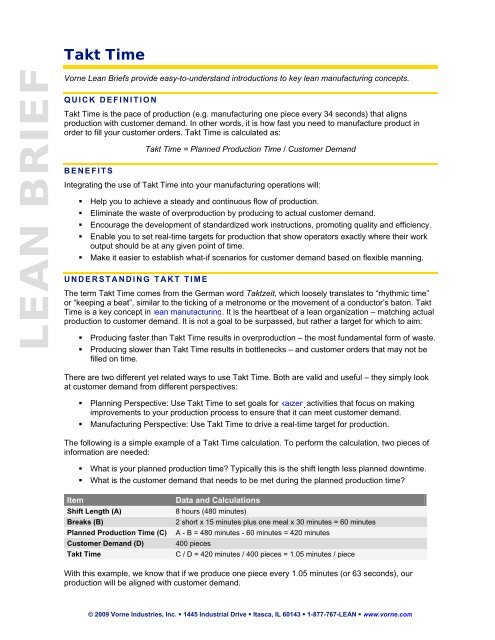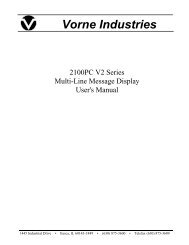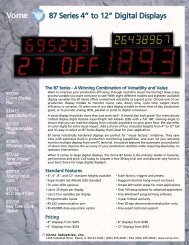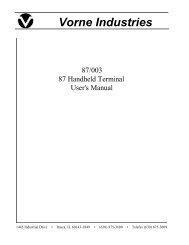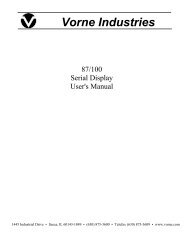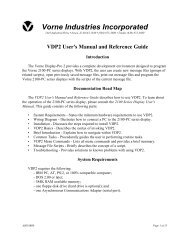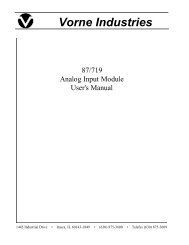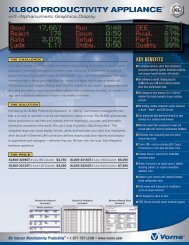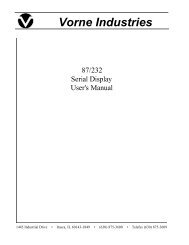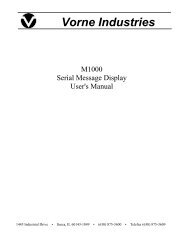Takt Time Lean Brief - Vorne Industries, Inc.
Takt Time Lean Brief - Vorne Industries, Inc.
Takt Time Lean Brief - Vorne Industries, Inc.
You also want an ePaper? Increase the reach of your titles
YUMPU automatically turns print PDFs into web optimized ePapers that Google loves.
<strong>Takt</strong> <strong>Time</strong><br />
LEAN BRIEF<br />
<strong>Vorne</strong> <strong>Lean</strong> <strong>Brief</strong>s provide easy-to-understand introductions to key lean manufacturing concepts.<br />
QUICK DEFINITION<br />
<strong>Takt</strong> <strong>Time</strong> is the pace of production (e.g. manufacturing one piece every 34 seconds) that aligns<br />
production with customer demand. In other words, it is how fast you need to manufacture product in<br />
order to fill your customer orders. <strong>Takt</strong> <strong>Time</strong> is calculated as:<br />
<strong>Takt</strong> <strong>Time</strong> = Planned Production <strong>Time</strong> / Customer Demand<br />
BENEFITS<br />
Integrating the use of <strong>Takt</strong> <strong>Time</strong> into your manufacturing operations will:<br />
• Help you to achieve a steady and continuous flow of production.<br />
• Eliminate the waste of overproduction by producing to actual customer demand.<br />
• Encourage the development of standardized work instructions, promoting quality and efficiency.<br />
• Enable you to set real-time targets for production that show operators exactly where their work<br />
output should be at any given point of time.<br />
• Make it easier to establish what-if scenarios for customer demand based on flexible manning.<br />
UNDERSTANDING TAKT TIME<br />
The term <strong>Takt</strong> <strong>Time</strong> comes from the German word <strong>Takt</strong>zeit, which loosely translates to “rhythmic time”<br />
or “keeping a beat”, similar to the ticking of a metronome or the movement of a conductor’s baton. <strong>Takt</strong><br />
<strong>Time</strong> is a key concept in lean manufacturing. It is the heartbeat of a lean organization – matching actual<br />
production to customer demand. It is not a goal to be surpassed, but rather a target for which to aim:<br />
• Producing faster than <strong>Takt</strong> <strong>Time</strong> results in overproduction – the most fundamental form of waste.<br />
• Producing slower than <strong>Takt</strong> <strong>Time</strong> results in bottlenecks – and customer orders that may not be<br />
filled on time.<br />
There are two different yet related ways to use <strong>Takt</strong> <strong>Time</strong>. Both are valid and useful – they simply look<br />
at customer demand from different perspectives:<br />
• Planning Perspective: Use <strong>Takt</strong> <strong>Time</strong> to set goals for kaizen activities that focus on making<br />
improvements to your production process to ensure that it can meet customer demand.<br />
• Manufacturing Perspective: Use <strong>Takt</strong> <strong>Time</strong> to drive a real-time target for production.<br />
The following is a simple example of a <strong>Takt</strong> <strong>Time</strong> calculation. To perform the calculation, two pieces of<br />
information are needed:<br />
• What is your planned production time? Typically this is the shift length less planned downtime.<br />
• What is the customer demand that needs to be met during the planned production time?<br />
Item<br />
Shift Length (A)<br />
Breaks (B)<br />
Planned Production <strong>Time</strong> (C)<br />
Customer Demand (D)<br />
<strong>Takt</strong> <strong>Time</strong><br />
Data and Calculations<br />
8 hours (480 minutes)<br />
2 short x 15 minutes plus one meal x 30 minutes = 60 minutes<br />
A - B = 480 minutes - 60 minutes = 420 minutes<br />
400 pieces<br />
C / D = 420 minutes / 400 pieces = 1.05 minutes / piece<br />
With this example, we know that if we produce one piece every 1.05 minutes (or 63 seconds), our<br />
production will be aligned with customer demand.<br />
© 2009 <strong>Vorne</strong> <strong>Industries</strong>, <strong>Inc</strong>. • 1445 Industrial Drive • Itasca, IL 60143 • 1-877-767-LEAN • www.vorne.com
ADVANCED TOPICS<br />
Comparing <strong>Takt</strong> <strong>Time</strong>, Cycle <strong>Time</strong>, and Ideal Cycle <strong>Time</strong><br />
A common point of confusion is the difference between <strong>Takt</strong> <strong>Time</strong>, Cycle <strong>Time</strong> and Ideal Cycle <strong>Time</strong>.<br />
They all represent the time to produce a piece – so how do they differ?<br />
• <strong>Takt</strong> <strong>Time</strong> is how often a piece must be produced to meet customer demand. It is often used to<br />
pace a production line, and it is a calculated number.<br />
• Cycle <strong>Time</strong> is the actual time to produce one piece. It is often used to gain an understanding of<br />
variations in production, and it is a measured number.<br />
• Ideal Cycle <strong>Time</strong> is the theoretical fastest possible time to produce one piece. It is used in the<br />
calculation of OEE, and it is usually derived from the “nameplate capacity” of a machine or<br />
through estimation by an industrial engineer.<br />
<strong>Takt</strong> <strong>Time</strong> for the Plant Floor<br />
A common use of <strong>Takt</strong> <strong>Time</strong> is to pace a production line. <strong>Takt</strong> <strong>Time</strong> can be used to drive a Target<br />
Counter, such that each time the <strong>Takt</strong> <strong>Time</strong> elapses, the Target Count increments. Typically, the Target<br />
Count is shown alongside the Actual Count (the number of good pieces that have been produced) and<br />
the Efficiency (the ratio of Actual Count to Target Count).<br />
Visualizing a target can be as simple as a white board that is manually updated once per hour or as<br />
sophisticated as an electronic scoreboard that automatically updates in real time. Visual feedback can<br />
be a very powerful motivator for operators, especially when it is in straightforward and understandable<br />
terms such as Target/Actual/Efficiency.<br />
Standardized Work<br />
Standardized work refers to instructions that capture the best practices for manufacturing a given item in<br />
an efficient and highly repeatable manner. It is important to note that through kaizen these best<br />
practices are likely to continue to improve over time.<br />
Standardized work helps to eliminate unwanted variability in the manufacturing process, which<br />
diminishes the opportunity for defects to be created. It also results in a much more consistent “per<br />
piece” manufacturing time (i.e. standardized work also helps eliminate variability in manufacturing time).<br />
Thus, in most cases standardized work instructions will have an associated <strong>Takt</strong> <strong>Time</strong>.<br />
As touched on earlier, <strong>Takt</strong> <strong>Time</strong> can serve as a goal for kaizen activities that focus on making<br />
improvements to the production process. The results of these activities should ultimately be captured in<br />
standardized work instructions.<br />
Flexible Manning<br />
Customer demand rarely holds steady – it often fluctuates in unpredictable ways (especially over the<br />
short term). One way to cope with this is flexible manning (other ways include overtime and inventory<br />
buffers). With flexible manning, work processes and the associated standardized work instructions are<br />
designed to run with a variable numbers of operators.<br />
• When customer demand is high, <strong>Takt</strong> <strong>Time</strong> is low, and more operators are utilized.<br />
• When customer demand is low, <strong>Takt</strong> <strong>Time</strong> is high, and fewer operators are utilized. This frees up<br />
operators to work on other processes or on improvement initiatives.<br />
COMMENTS OR QUESTIONS?<br />
We welcome your comments and questions. Contact us at: lean@vorne.com.<br />
© 2009 <strong>Vorne</strong> <strong>Industries</strong>, <strong>Inc</strong>. • 1445 Industrial Drive • Itasca, IL 60143 • 1-877-767-LEAN • www.vorne.com


